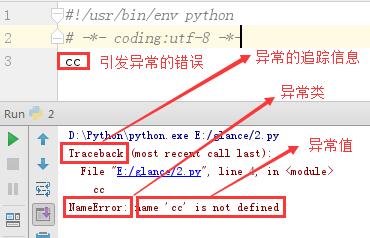异常处理
异常就是程序运行时发生错误的信号(在程序出现错误时,则会产生一个异常,若程序没有处理它,则会抛出该异常,程序的运行也随之终止),在python中,错误触发的异常如下
常见的错误类型和继承关系:点击

一、分成两种
- 语法错误(这种错误,根本过不了python解释器的语法检测,必须在程序执行前就改正)
- 逻辑错误
二、常见异常
- AttributeError 试图访问一个对象没有的属性,比如foo.x,但是foo没有属性x
- IOError 输入/输出异常;基本上是无法打开文件
- ImportError 无法引入模块或包;基本上是路径问题或名称错误
- IndentationError 语法错误(的子类) ;代码没有正确对齐
- IndexError 下标索引超出序列边界,比如当x只有三个元素,却试图访问x[5]
- KeyError 试图访问字典里不存在的键
- KeyboardInterrupt Ctrl+C被按下
- NameError 使用一个还未被赋予对象的变量
- SyntaxError Python代码非法,代码不能编译(个人认为这是语法错误,写错了)
- TypeError 传入对象类型与要求的不符合
- UnboundLocalError 试图访问一个还未被设置的局部变量,基本上是由于另有一个同名的全局变量, 导致你以为正在访问它
- ValueError 传入一个调用者不期望的值,即使值的类型是正确的
三、异常处理
为了保证程序的健壮性与容错性,即在遇到错误时程序不会崩溃,我们需要对异常进行处理
- 如果错误发生的条件是可预知的,我们需要用if进行处理:在错误发生之前进行预防
- 如果错误发生的条件是不可预知的,则需要用到try...except:在错误发生之后进行处理
|
1
2
3
4
5
6
7
8
9
10
11
12
13
14
15
16
17
18
|
"""#基本语法为try: 被检测的代码块except 异常类型: try中一旦检测到异常,就执行这个位置的逻辑#举例try: f=open('a.txt') g=(line.strip() for line in f) print(next(g)) print(next(g)) print(next(g)) print(next(g)) print(next(g))except StopIteration: f.close()""" |
|
1
2
3
4
5
6
7
8
9
10
11
12
13
14
15
16
17
18
19
20
21
22
23
24
25
26
27
28
29
30
31
32
33
34
35
36
37
38
39
40
41
42
43
44
45
46
47
48
49
50
51
52
53
54
55
56
57
58
59
60
61
62
63
64
65
66
67
68
69
70
71
72
73
74
75
76
77
78
79
80
81
82
83
84
85
86
87
|
#1 异常类只能用来处理指定的异常情况,如果非指定异常则无法处理。s1 = 'hello'try: int(s1)except IndexError as e: # 未捕获到异常,程序直接报错 print(e)#2 多分支s1 = 'hello'try: int(s1)except IndexError as e: print(e)except KeyError as e: print(e)except ValueError as e: print(e)#3 万能异常Exceptions1 = 'hello'try: int(s1)except Exception as e: print(e)#4 多分支异常与万能异常#4.1 如果你想要的效果是,无论出现什么异常,我们统一丢弃,或者使用同一段代码逻辑去处理他们,那么骚年,大胆的去做吧,只有一个Exception就足够了。#4.2 如果你想要的效果是,对于不同的异常我们需要定制不同的处理逻辑,那就需要用到多分支了。#5 也可以在多分支后来一个Exceptions1 = 'hello'try: int(s1)except IndexError as e: print(e)except KeyError as e: print(e)except ValueError as e: print(e)except Exception as e: print(e)#6 异常的其他结构s1 = 'hello'try: int(s1)except IndexError as e: print(e)except KeyError as e: print(e)except ValueError as e: print(e)#except Exception as e:# print(e)else: print('try内代码块没有异常则执行我')finally: print('无论异常与否,都会执行该模块,通常是进行清理工作')#7 主动触发异常try: raise TypeError('类型错误')except Exception as e: print(e)#8 自定义异常class EgonException(BaseException): def __init__(self,msg): self.msg=msg def __str__(self): return self.msgtry: raise EgonException('类型错误')except EgonException as e: print(e)#9 断言:assert 条件assert 1 == 1assert 1 == 2#10 总结try..except"""1:把错误处理和真正的工作分开来2:代码更易组织,更清晰,复杂的工作任务更容易实现;3:毫无疑问,更安全了,不至于由于一些小的疏忽而使程序意外崩溃了;""" |



